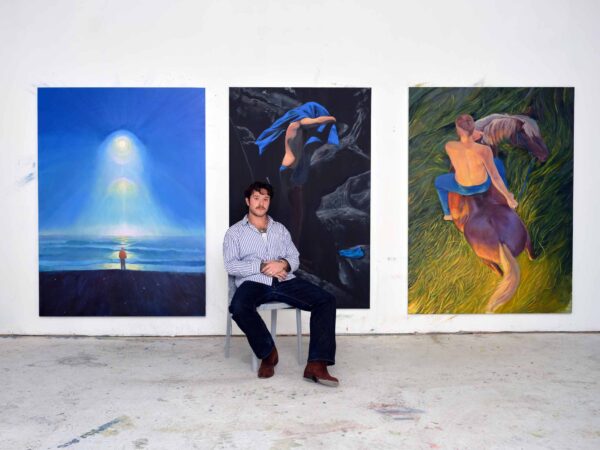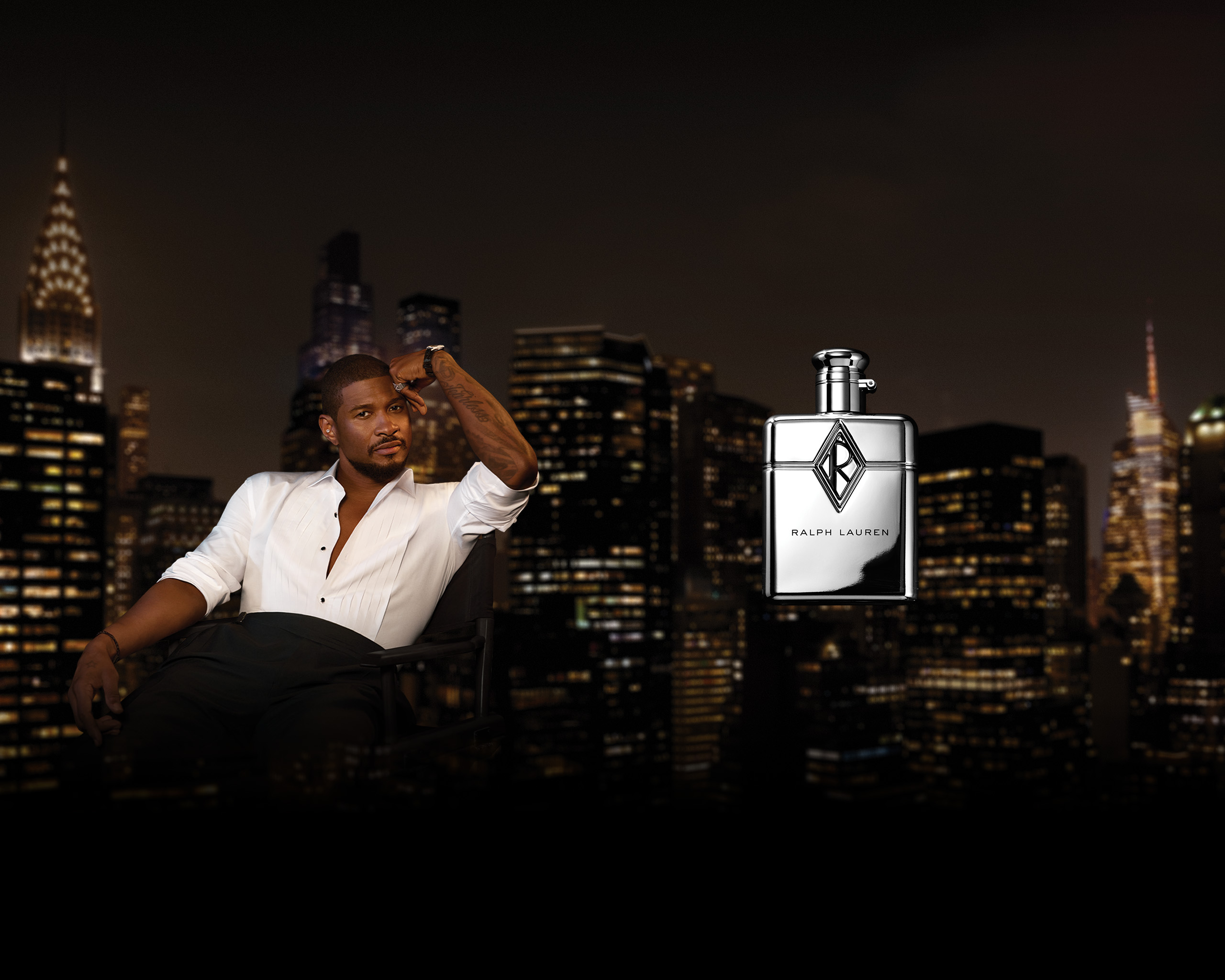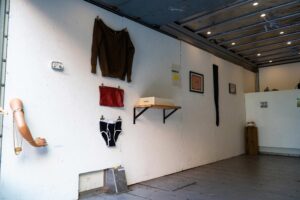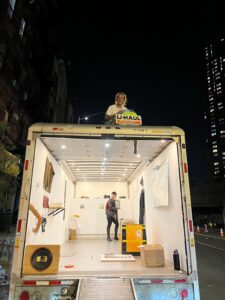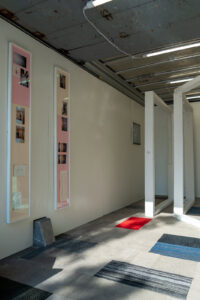Fueled by gasoline and a guerrilla spirit, the roving arts exhibition space is challenging traditional modes of display
Almost exactly a year ago, an inconspicuous U-Haul truck parked outside the Metropolitan Museum of Art. In lieu of cardboard boxes and furniture bound in stretch wrap, the truck’s cargo was an assemblage of contraband objects taken from various workplaces. The truck was the U-Haul Gallery, on its third night of The Show of Stolen Goods, an exhibit curated by Jack Chase, the gallery’s Head of Global Strategy, and artist Victoria Gill. “More than 1000 artifacts in the Metropolitan Museum of Art catalog are linked to alleged looting and trafficking figures,” an Instagram post advertising the show cites. “Everyone’s doing it” reads the caption below.
Since then, the up-and-coming gallery has challenged and transcended fraught legacies of old-guard exhibitionary models, both in its ontology and organization—all while operating exclusively out of the eponymous, ubiquitous moving trucks.
In the U-Haul Gallery world, nothing is sacred and everything is stolen, or at least up for grabs, even ideas. The idea for a truck show was conceived by founder James Sundquist in spring 2024 after he stored one of his paintings in the back of a U-Haul during a studio move amid a fruitless search for affordable gallery space. Chase says he had the idea right around the same time. A few months later, the recently introduced pair convened at downtown’s Landmark Diner to discuss the idea of hosting The Show of Stolen Goods out of the U-Haul Gallery, marking the start of their collaboration.
A little under a year after The Show of Stolen Goods and following several forays to art fairs across the country, I meet Chase and Sundquist back at the Met. This time, they are just visiting the museum. As they reflect on their own gallery’s origins and trajectory, we peruse the museum’s permanent collections. The pair are awestruck by some, unimpressed by others, drawing analogies between Jackson Pollock and Michael Jackson, Charles Ray and Leonard Cohen, but almost always in remarkable agreement. They share what they call an “air brain,” described as a sort of data cloud where their mutual thoughts live.
Surrounded by the Met’s mass of works, Sundquist notes a wave of fatigue. “I feel like I just got hit by a cannonball,” he jokes. “Yeah, the canon’s cannonball,” Chase laughs. Scholars have attempted to untangle this web of power systems, which seem to govern museums and exhibitionary spaces. In a 1988 essay titled “The Exhibitionary Complex,” author Tony Bennett elaborates on French philosopher Michel Foucault’s theories on surveillance, spectacle, and discipline, drawing parallels between the development of the modern carceral system and the rise of museums across the 19th century, to argue that museums and exhibitionary spaces are inherently hegemonic institutions through which the nation state is enforced. In this ‘exhibitionary complex,’ artifacts and the narratives of power and progress implicit in their arrangement are rendered objective through a carefully historicized display, and visitors are subject to their own exhibition and hierarchization, which forces them to self-regulate based on internalized cues.
Hijacking and subsequently subverting these governing codes is at the crux of U-Haul Gallery’s approach. “We’re culturally appropriating the art world power culture to some degree. But there’s definitely much more of an emphasis on accessibility, which I think is inherent in the medium of the mobile gallery,” Sundquist shares. This co-option is evident down to his choice of ensemble—Sundquist wears a suit and tie to almost every curbside show. “We have an active interest in appropriating all of the vernacular that is associated with contemporary arts presentation,” Chase adds, but he considers the gallery a sort of “absurdist play on it.”
Striking a perfect medium, deciding which aspects of the conventional gallery format to use and which to discard, is the hack that encourages passersby to feel comfortable entering a gallery-truck in the first place. Yes, the walls are white, but instead of a silent, sequestered space, visitors are invited to ascend the loading ramp and explore the art to the soundtrack of slacker rock and chatter, or just pass by and ask “what is this?,” perhaps even purchase a T-shirt. The mobility of the U-Haul Gallery has also allowed it to traverse areas of culture that would otherwise be disparate. The gallery has dabbled in fashion and sports, often parking outside the major house storefronts in SoHo and was the only gallery at the Knicks playoffs this past winter. The truck was recently stationed outside Tompkins Square Skate Park, where special guests kickflipped over a U-Haul Gallery painted ramp.
Yet the race against what Sundquist calls “the New York City space-time-art-money paradigm” remains at the heart of U-Haul Gallery’s ethos. A Chinatown gallery space about the size of a U-Haul truck can cost thousands of dollars per month, whereas a U-Haul truck costs around $29.99 per day. Chase notes that the financial reality of the U-Haul Gallery is significantly less burdensome than a typical gallery model. “It allows us to not only pay the artists that we show more money, but we can also show work that might be less financially feasible or wise for a traditional gallery show.” The Show of Stolen Goods is an apt example of such a case, and so is Jacob Muilenburg’s Waterfront Property, a show the gallery hosted this past June, itself a direct reflection on the exorbitant cost of NYC real estate. A recent financial disclosure on the gallery’s Instagram reports a net profit of $7.13 in the first half of 2025 which likely won’t afford the duo a coffee each in New York City, depending where you go.
This weekend, from September 5-7, for its inaugural U-Haul Art Fair, the gallery will be stationed in Chelsea, coinciding with The Armory Show. The fair will consist of 10 U-Haul trucks or “booths,” each exhibiting work from a different gallery or art collective, a U-Haul Gallery truck, and a press truck. In the guerrilla spirit of its drivers, the gallery’s message will remain mobile at this weekend’s fair and beyond, as the U-Haul Gallery makes its way to London and Paris this fall. “Every show has a narrative arc,” says Sundquist. “That’s part of what makes it compelling. For us, too, that’s what keeps it engaging. It’s not just, ‘oh, gotta go open the gallery.’ Every day is another opportunity to steal some power.”









